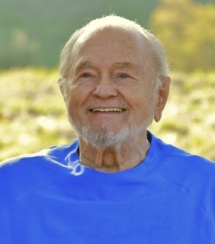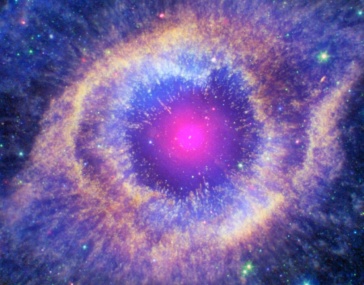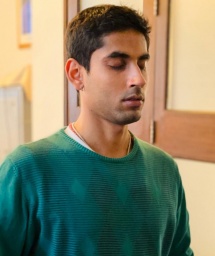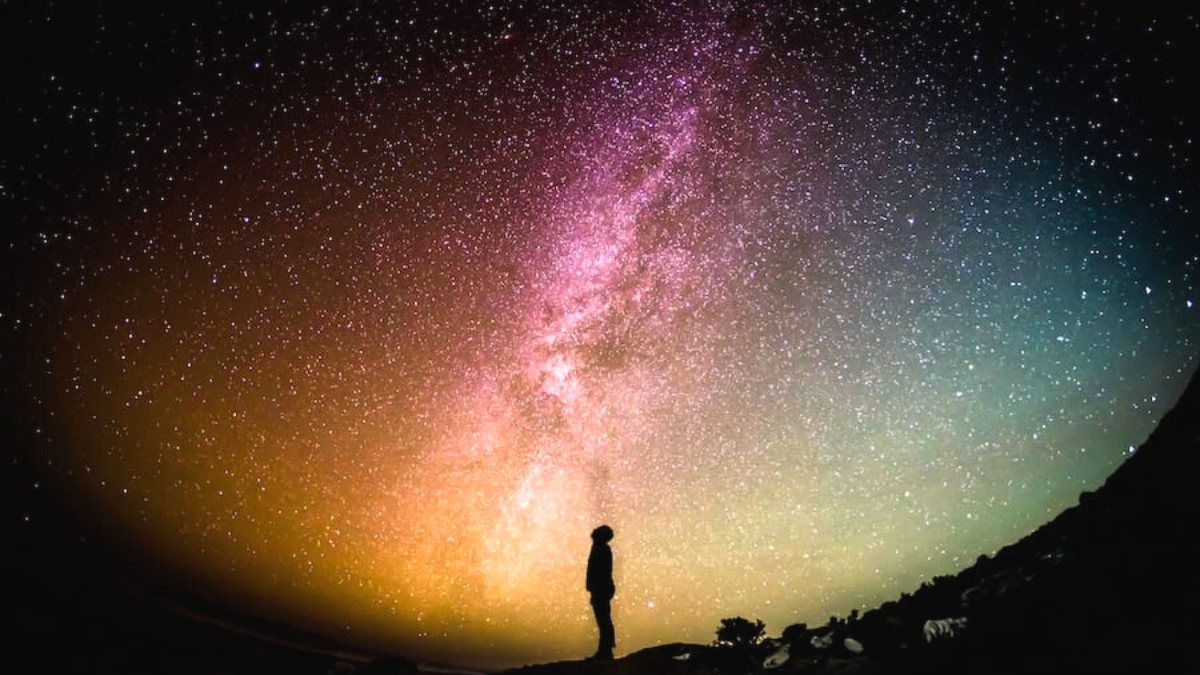According to modern science, the world is meaningless, the Universe came out of nothing, and evolution is merely a random phenomenon. However, there’s one thread that runs through everything – animate or inanimate – which gives meaning to all that is – Consciousness. This is where we’re headed. The exploration of consciousness alone will get us to where we want to go. Learn why that is the case by reading the article below!
According to what we call science today, the Universe appeared out of nowhere. Everything fell perfectly into its own place —matter, energy, and all the laws that govern them.
While only a few of us take time to question this hypothesis, it’s worth contemplating upon. Because whether this statement is true or not will determine what kind of life each one of us leads.
Thinking that the Universe came out of nothing would be like saying that the device you’re reading this article on also appeared out of nowhere. That all the hardware and the batteries running the device fell into a perfect position, governed by the laws of circuits that were also defined out of nothing. Rupert Sheldrake describes it like this:
“It’s almost as if science said, ‘Give me one free miracle, and from there the entire thing will proceed with a seamless, causal explanation.’ The one free miracle was the sudden appearance of all the matter and energy in the universe, with all the laws that govern it.”
Seems crazy, right?
Let’s step back for a moment though. Before even trying to find out whether the Universe actually is the result of a random event, it’s worth asking, “Why do we even care?”
The reason is simple. Consider how your life would be affected depending upon the worldview you pick.
If you choose to believe that the Universe came out of nothing, then it is natural for you to feel isolated, alienated, lonely, and fearful. In a world created haphazardly, all of us would be deemed as separate entities, born without any purpose. Life, then, would be only about ensuring our own survival, even if it comes at the cost of others.
Now imagine that you believe the Universe was created by a central force. This force not only guides the planets, stars, and all the celestial bodies in the Universe but also guides your life.
This means that all of us are, in fact, one. We are not separate entities here to ensure our own survival at the cost of others. We are one because the same force that resides in me resides in you and every other thing in this world. In a world like this, one feels connected, loved, hopeful, and peaceful.
Sadly, science, for most of its existence, has tried to validate the former worldview. The more scientists insist on the wrong worldview, the more you feel fearful and disconnected from your inner reality.
Even if you don’t feel this yourself, you see it in the malaise of the people around you. Think of how many people today feel lonely, depressed, and disconnected from others and their own higher selves. They lack the right worldview which enables them to have a connection with something higher than themselves.
The latter worldview, on the other hand, has always been confirmed by yogis, saints, sages, and a lot of religions. In yogic science, the force from which the Universe came, and the force which guides our lives, is Consciousness.
 Just as your life is run by your individual consciousness, the Universe is created and governed by Cosmic Consciousness. When Swami Kriyananda was asked, “Who is God?” he said, “He is not a person. He is neither He nor She, and He is both He and She. He is everything our souls ever craved: perfect bliss, immortality, complete consciousness – Satchidananda, as He is defined by those who are familiar with the concept of absolute perfection.”
Just as your life is run by your individual consciousness, the Universe is created and governed by Cosmic Consciousness. When Swami Kriyananda was asked, “Who is God?” he said, “He is not a person. He is neither He nor She, and He is both He and She. He is everything our souls ever craved: perfect bliss, immortality, complete consciousness – Satchidananda, as He is defined by those who are familiar with the concept of absolute perfection.”
He added further: “‘Who is God?’ may be paired with another, equal question: ‘Who are we?’ For in our deepest reality, what is left when we strip away all superficial definitions is that germ of consciousness within. There, as Jesus Christ implied, lies the secret of God’s reality.”
Skeptics would perhaps ask, “Why, then, hasn’t science been able to validate the existence of consciousness?”. I may have the answer to that question. Let’s take a look.
Looking for the Right Things in the Wrong Places
Mulla Nasreddin was a Sufi mystic who lived in the 13th century in present-day Turkey. His methods of teaching were not sermons or mere repetition of scriptural knowledge. He used one of the most powerful teaching methods—stories.
These stories were full of jokes and humorous anecdotes, followed by a moral. Let’s look at one of his stories.
“Once Nasreddin lost his ring in the living room. He searched for it for a while, but since he could not find it, he went out into the yard and began to look there.
His wife, who saw what he was doing, asked: ‘Mulla, you lost your ring in the room, why are you
looking for it in the yard?’
Mulla stroked his beard and said: ‘The room is too dark and I can’t see very well. I came out to the courtyard to look for my ring because there is much more light out here.’”
Because we’re looking for the proof of consciousness in the wrong places, we’re unable to validate its presence. You see, a major difference between matter and consciousness is that we can measure and see the matter, but consciousness has to be experienced internally.
Most researchers are looking for proof of the existence of consciousness outside themselves. What they don’t realize is that it cannot be perceived with the intellect or the mind alone.
Just because the ‘room’ inside us is dark, we don’t put the effort to look there. All this while, we waste effort searching for Truth outside.
Let’s take the case of the light bulb as another analogy. A light bulb can shine the light on everything around it but not on the power that illuminates it. Similarly, you can see everything around you but not the consciousness that animates you. It’s beyond the normal functioning of the mind, beyond the limits of intellect, and beyond thought.
Since we cannot validate the presence of consciousness outside us, or cannot contemplate it using our intellect, we deny its existence. This doesn’t seem right, does it? Can you quantify or measure a mother’s love for a child? No. But does that mean it’s not there? No, again. So is the case with consciousness.
Now, even though I’ve criticized science for its follies, there are a few prominent individuals who’ve acknowledged the presence of this higher reality.
Those Who Know, Just Know. Those Who Don’t, Don’t
Max Planck was a Nobel Prize-winning German physicist and is known as the father of quantum theory. His seminal work in the field of theoretical physics led the way to many advances throughout the 20th century.
He said,
“I regard consciousness as fundamental. I regard matter as derivative from consciousness. We cannot get behind consciousness. Everything that we talk about, everything that we regard as existing, postulates consciousness.”
Next, consider what James Jeans, a physicist, astronomer, and mathematician had to say,
 “The stream of knowledge is heading towards a non-mechanical reality; the Universe begins to look more like a great thought than like a great machine. Mind no longer appears to be an accidental intruder into the realm of matter… we ought rather hail it as the creator and governor of the realm of matter” — The Mysterious Universe
“The stream of knowledge is heading towards a non-mechanical reality; the Universe begins to look more like a great thought than like a great machine. Mind no longer appears to be an accidental intruder into the realm of matter… we ought rather hail it as the creator and governor of the realm of matter” — The Mysterious Universe
Further, when he was asked in an interview with The Observer, “Do you believe that life on this planet is the result of some sort of accident, or do you believe that it is a part of some great scheme?” he said,
“I incline to the idealistic theory that consciousness is fundamental and that the material universe is derivative from consciousness, not consciousness from the material universe… In general, the universe seems to me to be nearer to a great thought than to a great machine. It may well be, it seems to me, that each individual consciousness ought to be compared to a brain-cell in a universal mind.”
And to bring more weight to my argument, let me quote Einstein, the person who wanted to express God in an equation:
“A human being is part of a whole, called by us the “Universe,” a part limited in time and space. He experiences himself, his thoughts and feelings, as something separated from the rest — a kind of optical delusion of his consciousness. This delusion is a kind of prison for us, restricting us to our personal desires and to affection for a few persons nearest us. Our task must be to free ourselves from this prison by widening our circles of compassion to embrace all living creatures and the whole of nature in its beauty.”
— Written in a letter as consolation to Robert S. Marcus, political director of the World Jewish Congress, whose young son had just died of polio
Interesting right? Einstein often called his belief system a “cosmic religion” because for him “science without religion is lame, religion without science is blind.” [1]
The Scientist Who Went Away From Matter Consciousness
Eben Alexander became famous after his book Proof of Heaven: A Neurosurgeon’s Journey into the Afterlife hit the New York Times bestseller list. He described in his book his experience of the afterlife as he transitioned in and out of consciousness.
In 2008, he became ill with acute bacterial meningoencephalitis. Meningitis affects the meninges, the membranes that surround the brain and spinal cord and protect the central nervous system. Bacterial meningitis is the most serious type of meningitis. It can lead to death or permanent disability
His condition, with a rapid decline in neurologic function, conferred a 90 per cent mortality rate.
For one week he was in a coma, brain dead. Yet, on the seventh day, when he opened his eyes his expressions were startling. He writes in his personal account,
 “A family friend who was there could not get over how my amazed expression looked more like the astonished gaze of an infant, not like what one would expect from an adult returning from an unconscious state.”
“A family friend who was there could not get over how my amazed expression looked more like the astonished gaze of an infant, not like what one would expect from an adult returning from an unconscious state.”
A person recovering from such a state is not expected to live, let alone remember experiences from the coma. “Thus, you can imagine my surprise at remembering an elaborate and rich odyssey from deep within coma that comprised more than 20,000 words by the time I had written it all down during the six weeks following my return from the hospital”, he continues.
While I won’t go into the details of what he saw, he was clearly transported to a different level of consciousness. For him, God seemed too puny a word to describe the power, majesty, and awe he had experienced.
He further says, “I originally referred to that deity as Om, the sound that I recalled from that realm as the resonance within infinity and eternity.” As a disciple of Yogananda, I can’t help but think how true these experiences seem in the light of his teachings and the broader yogic science.
All his experiences can be conveniently disregarded as hallucinations, as the traditional scientific community has been doing for ages. Yet, Eben argues that “The conventional reductive materialist (physicalist) model embraced by many in the scientific community, including its assumption that the physical brain creates consciousness and that our human existence is birth-to-death and nothing more, is fundamentally flawed.”
For Eben, the world will never be the same. He’s now trying to convince the scientific community to graduate from kindergarten and explore the possibilities of consciousness.
There’s Only One Way to Find The Truth
As you can see from Eben’s experience, those who get a glimpse of such consciousness cannot stop talking about it. Therefore, it is not a hallucination but is as real as the material universe around us. (You can read about a similar experience here).
These Near-Death Experiences (NDEs) have long remained a source of mystery for science since they are always unable to explain what happened. Key characteristics of such NDEs include a sense of profound peace, of unconditional love, of leaving the physical body, and of light,
Eben himself came up with several models in neurophysiology and neuroanatomy, but none could explain what he experienced!
However, NDEs are not the only way you can go into such states.
There’s a scientific method that yogis and sages have been teaching for millennia — meditation.
It’s how you can calm the senses, and still the body, mind, and thoughts. Once you do that (a herculean task in itself), then you can glimpse the fact that you are something beyond the body, mind, or thoughts. You are consciousness. The same consciousness manifest in all objects of creation – animate or inanimate.
 You can only experience this Reality beyond the fringe of your mind, once everything comes to a halt through meditation. If Descartes said, “I think, therefore I am,” the yogis would say, “When I stop thinking, then I really am.”
You can only experience this Reality beyond the fringe of your mind, once everything comes to a halt through meditation. If Descartes said, “I think, therefore I am,” the yogis would say, “When I stop thinking, then I really am.”
In this sense, everything you’re experiencing is just a delusion trying to get you away from experiencing that Reality. And if that Reality is the source and the essence of our being, there’s no reason to not try knowing it.
This Reality (or Consciousness) is the ultimate frontier of human development and the only goal worth striving for.
[1] Interestingly, even though Einstein wanted God on a piece of paper, he realized that even if he got a near-perfect equation, it would be useless. Doing something like this would be like describing Mozart’s music in the form of sound waves. You could potentially do it, but would you really grasp the spirit and the meaning of the music?
Related Video
